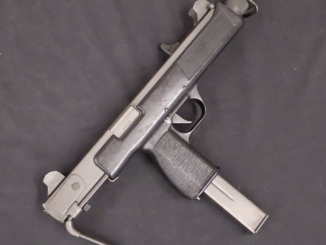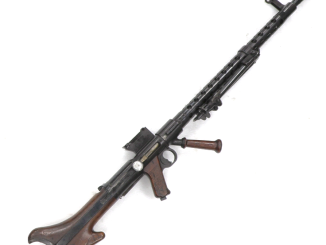Rudolf Frommer was a self-taught engineer and firearms designer who worked his way up through the FEG concern in Budapest to eventually hold the position of CEO. During this time he developed a series of long-recoil, rotating-bolt pistols culminating in the Frommer Stop, which was adopted by the Austro-Hungarian military. These pistols began with the 1901 model (actually patented in 1903), which was a quite large handgun chambered for an early version of the 8mm Steyr cartridge.
The 1901 model Frommer pistol used a 10-round internal magazine fed by stripper clips, and those clips would be a primary reason the pistol was rejected when tested by the US military in 1904. American testing officers complained that the clips were finicky to use, and could easily cause jams if not handled just right (for example, yanked briskly out of the action after charging). The American testing board also criticized the gun for its 8mm cartridge (the Americans wanted nothing less than 11.25mm), and for the weapon not obscuring its sight picture when locking open on the last round.
Only about 200 Frommer 1901 pistols were made before the design was revised in the 1906 model, which was substantially smaller and chambered for a 7.65mm cartridge slightly shorter than the .32ACP. The 1910 model finally achieved a reasonable (if small) serial production of a few thousand guns, The 1912 “Stop” model introduced a much more conventional frame and grip design, and was the breakout success of the series, with several hundred thousand made.




That button really is a safety, blocking both the hammer (in cocked as well as uncocked position) and the sear.
Check the Frommer chapter in Mötz & Schuy’s book – I’m not sure how good your German is, but between the drawings on p608 and 610, and the photos on p614 and 615, it should be obvious enough how it’s meant to work.
The odd thing about Frommer’s designs was his insistence on using a long-recoil locked-breech system for cartridges that generally get along just fine with simple blowback actions. As such, his designs tended to ens up heavier and more complicated (and thus more expensive) than they really needed to be.
The 8mm Frommer 1901 was chambered for the 8mm Roth round, immediate predecessor of the 8mm Roth-Steyr. Technically, it was an 8 x 19mm with ballistics much better than a .32 ACP. (116 grain @ 1090 for 309 FPE.) This puts it midway between the .38 Special and 9 x 19mm in power.
You could argue that this is about as powerful a round as you’d want to try in a straight blowback, as with the 9 x 18mms like the Ultra or Makarov (it outpowers both). Or that it would really have made more sense in a short-recoil, locked breech system. Putting it in a long-recoil system doesn’t make a lot of sense.
But this isn’t the mot unusual Frommer. That title goes to the Frommer Baby, a drastically-scaled-down “Stop” chambered for .25 ACP. It was slightly heavier than the blowback .25s of its time, and of course more expensive. It never sold well. This shows one next to a full-grown “Stop”;
http://14544-presscdn-0-64.pagely.netdna-cdn.com/wp-content/uploads/2013/02/Frommer-Stop-and-Baby-Stop.jpg
The thing is, the Baby could probably have been made in .32 or even .380 ACP. In those chamberings, its long-recoil system would have been able to reduce the kick in such a compact piece, the calibers would have been more effective in defense, and it might have filled a real need.
cheers
eon
I concur with your view. It was one of pistols of “pioneering” era based on pure creativity without sound scientific base; long gone and therefor revived on this blog.
I suspect that Frommer starting from self-loading or machine rifle (in this case long-recoil would be sane to lower rate-of-fire) and later used experience gained in the field of automatic pistol. As we known today, long-recoil is not best principle for automatic pistol (it was also used in other early automatic pistol – MARS, also complicated, in which cartridge was not rammed straight into chambered, but moved backward, upward and rammed, and of very powerful (by 1890s automatic pistols standards) cartridges).
Considering that long-recoil give relatively low Rate-Of-Fire it probably might be of some use in machine pistols, but this category of weapon rather go with various forms of Rate-Of-Fire reduced, so apparently using long-recoil is not cost-effective even there.
You may be right – Frommer had fixation on long recoil guns, be it pistols or rifles. With pistol, there seem to be little logic in it, but rifle might be different story. As Ian pointed out in pertinent piece, with this system there is “no case with chamber pressure on extraction”; it is completely safe.
You conclusion of undue complexity is correct as far as I can tell. There is very little go gain there, unless some sophisticated means of recoil attenuation is employed. What once starts to move must be stopped – somehow.
Now I have question: what was first: FROMMER STOP xor FROMMER BABY?
If second is earlier it make some sense: Frommer might consider that it is not good idea to make such small automatic pistol firing .32 Auto or .380 Auto cartridge as blow-back operated, then as it was made to work intended it was simply elongated to fit different market.
“I suspect that Frommer starting from self-loading or machine rifle (in this case long-recoil would be sane to lower rate-of-fire) and later used experience gained in the field of automatic pistol.”
In fact, Frommer’s first (and successfull) patents (from 1899) and designs (Frommer 1901M) were long recoil operated semi-automatic pistols.
About Frommer’s fixation on long recoil operated guns. You should consider that:
– Frommer only had maturity examination/high school diploma, and never attended in formal engineering training. Hungarian historians suspect that, Dezső Raiss, a very talented (and a former private) gunsmith from the factory’s experimental workshop, gave him significant help. When in 1914 Franz Joseph I ennobled Frommer with Fegyverneki title, he also awarded Raiss. Nowadays we call Frommer’s occupation as technical manager. (I should also mention, the Hungarian Chamber of Engineers laureated him to mechanical engineer.)
– Yes, it was a pioneering era: in 1903, when the Frommer 1901M appeared, one of the first semi-automatic pistols, the Borchardt C93 was only ten years old. (Hugo Borchardt was a FÉG employee before the WWI – but this is an another story.)
– Krnka didn’t like the blowback action, and he written a book against it (“Die principiellen Eigenschaften der automatischen Feuerwaffen”), under the pseudonym “Kaisertreu”.
– Question: in the early 1900’s, the loads of the cartridges were accurate enough? In case of overloaded cartridge, the combination of long recoil action and rotating bolt head safer.
…as far as I know. This topic needs much more research. Unfortunately, during the WWII many documents lost forever (additional reason, why I hate war…).
Be careful with Manowar’s Hungarian Weapons & History [www.hungariae.com]: it isn’t so accurate. Unfortunately, many documents lost forever during the 20th century, and there are very few people, who read the remains.
“That title goes to the Frommer Baby, a drastically-scaled-down “Stop” chambered for .25 ACP.”
FALSE.
“Baby could probably have been made in .32 or even .380 ACP”
It was done in this, please see 1st photo from top here:
http://tonnel-ufo.ru/eanglish/weapon/gun-frommer-baby.php
or any image of decent quality of left side of FROMMER BABY, there is following text:
FEGYFVRGYAR-BUDAPEST-FROMMER-PAT. BABY CAL 7.65mm(.32)
similarly version with CAL 9mm(.380)
For similar in caliber-size-time automatic pistol, see Bayard automatic pistol:
http://unblinkingeye.com/Guns/Bayard/bayard.html
“Baby could probably have been made in .32 or even .380 ACP”
http://www.hungariae.com/FromBaby.htm states that It was never made in 6.35mm, as sometimes claimed. and even states that is use 7.65x17mm Frommer (.32acp loaded hot) or 9mm Frommer (.380acp loaded hot)
If we compared the Frommer to a Colt 1908 Pocket Hammerless, which would be better for stopping a charging saw-swinging maniac?
You ask about comparison: Frommer Stop vs Colt 1908 Pocket Hammerless xor Frommer Baby vs Colt 1908 Pocket Hammerless?
Oops, I should have specified the Frommer Stop…
“Frommer Stop”
I will say that there are quite similar, with Frommer Stop having slight advantage due to hotter loaded cartridge.
According to hungariae .32 version of Frommer stop has following ballistic:
Muzzle velocity: 4.65g @ 342m/s (1125 fps) @ 100mm barrel
when ballisticsbytheinch give for .32 Auto (71gr FMJ):
Muzzle velocity: 71gr @ 939 fps @ 4 inch barrel
Looking at more modern cartridges Frommer 7,65mm cartridge is quite similar to .32 H&R revolver cartridge.
“But this isn’t the mot unusual Frommer. That title goes to the Frommer Baby, a drastically-scaled-down “Stop” chambered for .25 ACP. It was slightly heavier than the blowback .25s of its time, and of course more expensive. It never sold well. This shows one next to a full-grown “Stop”;”
As said before Frommer Baby never was produced in .25 Auto. Frommer designed later .25 automatic pistol but it was blow-back: Frommer Liliput
http://www.hungariae.com/FromLili.htm
(and interestingly it has possibility to swap barrel and magazine between .22 rim-fire and .25 Auto), it was later up-scaled to create FEMARU 29M (firing 9x17mm Browning cartridge) and later improved into FEMARU 37M (firing 9x17mm or 7,65x17mm cartridge)
One of 3 Frommer pistols I don’t have. Gonna go for big bucks (A 1906 went for $46K)
“rejected when tested by the US military in 1904”
Hungariae has page about this automatic pistol containing cut-away drawing
http://hungariae.com/From01.htm
It states that it was also tested in Sweden and rejected due to lack of detachable magazine (Sweden finally adopted Husqvarna m/1907 pistol). Anyway looking at cross-section: would it be possible to redesign it for usage of said magazine?
Yes – the model 1906 is basically a 1901 with a detachable magazine.
Also Frommer’s first adopted pistol, the Frommer 1910M has detachable magazine. By the way: during the Swedish trials, Frommer’s 1901M and Luger’s Parabellum were the bests from the viewpoint of accuracy and penetration.